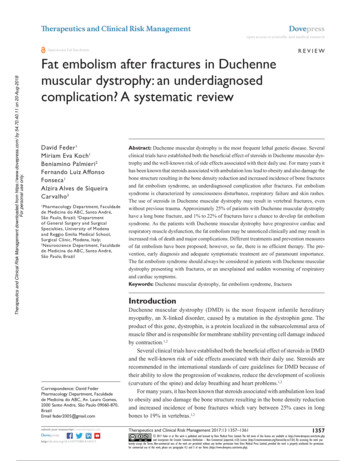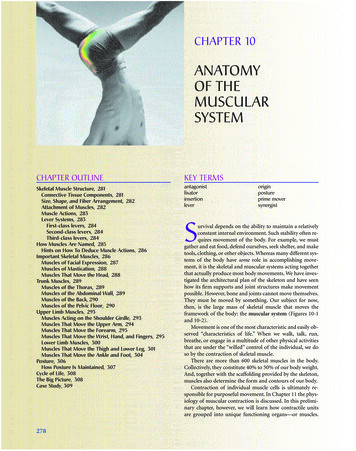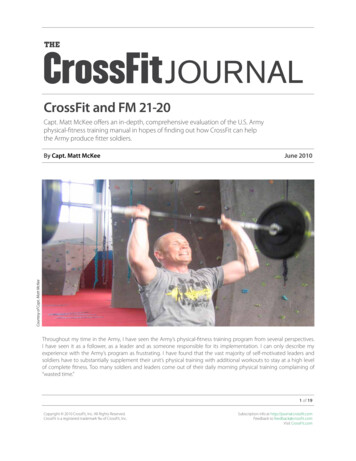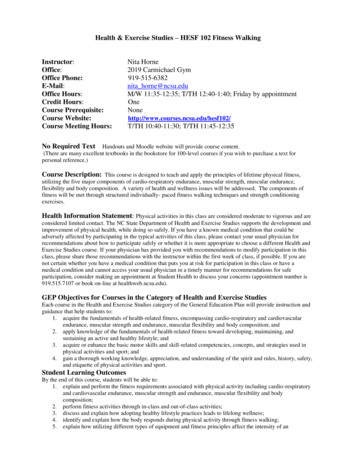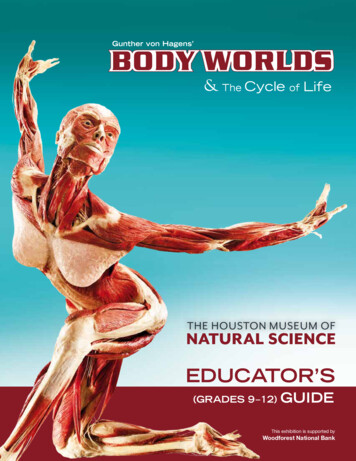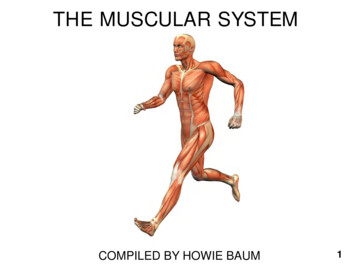
Transcription
THE MUSCULAR SYSTEMCOMPILED BY HOWIE BAUM1
Muscles make up the bulk of the bodyand account for 1/3 of its weight.!!Blood vessels and nerves run to everymuscle, helping control and regulate eachmuscle’s function.
The muscular system creates body heatand also moves the: Bones of the Skeletal system Food through Digestive system Blood through the Circulatory system Fluids through the Excretory system
MUSCLE TISSUEThe body has 3 main types of muscle tissue1) Skeletal, 2) Smooth, and 3) CardiacSKELETAL MUSCLESMOOTH MUSCLECARDIAC MUSCLE
Skeletal muscles attach toand move bones bycontracting and relaxing inresponse to voluntarymessages from thenervous system.Skeletal muscle tissue iscomposed of long cellscalled muscle fibersthat have a striatedappearance.Muscle fibers areorganized into bundlessupplied by blood vesselsand innervated by motorneurons.
Muscle structureSkeletal (striated or voluntary)muscle consists of denselypacked groups of hugelyelongated cells known asmyofibers.These are grouped into bundles(fascicles).A typical myofiber is 2–3centimeters ( 3/4–1 1/5 in)long and 0.05millimeters(1/500 inch) in diameter and iscomposed of narrowerstructures – myofibrils. Thesecontain thick and thinmyofilaments made up mainlyof the proteins actin andmyosin. Numerous capillarieskeep the muscle supplied withthe oxygen and glucose neededto fuel contraction.
Skeletal Muscles Skeletal muscles attach to bones by tendons(connective tissue) and enable movement. Skeletal muscles are mostly voluntaryFeel the back ofyour ankle tofeel yourAchilles tendon- the largesttendon in yourbody.
The typical male body contains approximately 640muscles, which compose around two-fifths of its weight.The same number in a female body make up a slightlysmaller proportion.A typical muscle spans a joint and tapers at each end intoa fibrous tendon anchored to a bone. Some musclesdivide to attach to different bones.
TENDONSTendons are tough, fibrouscords of connective tissuethat link skeletal muscles tobones.Within them, Sharpey’s fiberspass through the bonecovering (periosteum) toembed in the bone.Tendons in the hands andfeet are enclosed in selflubricating sheaths to protectthem from rubbing againstthe bones.From the hand bones,tendons extend upwards tomuscles near the elbow.
Tendons and TendonSheaths in the hand.
SKELETAL MUSCLESSkeletal muscles are also knownas voluntary muscles, since wecontrol their actions at will, and asstriated muscles, from theirmicroscopic appearance.In the muscular system, skeletalmuscles are connected to theskeleton, either to bone or toconnective tissues such asligaments.Muscles are always attached attwo or more places.When the muscle contracts, theattachment points are pulledcloser together; when it relaxes,the attachment points move apart.
A second type is smoothmuscle, in the walls of bodyparts such as the airways,stomach, Alimentary canal,and blood vessels.This is called involuntarymuscle, because it worksautomatically rather thanunder conscious control, orsmooth muscle, from itsmagnified appearance
Smooth muscle lines organs and isinvoluntary.– moves food through digestive organs– empties liquid from the bladder– controls width of the blood vesselsSmooth muscle around thisartery allows the artery toregulate blood flow byshrinking and expanding.SMOOTH MUSCLE
The third type is cardiac muscle,making up the walls of the heart.It is part of both the MuscularSystem and the CirculatorySystem.It is responsible for circulatingblood throughout the body.It has its own pacemaker forrhythmic beating.
The heart wall iscomposed of three layers.The middle layer, themyocardium, isresponsible for the heart’spumping action.Cardiac muscle, foundonly in the myocardium,contracts in response tosignals from the cardiacconduction system tomake the heart beat.Cardiac muscle is madefrom cells calledcardiocytes.
Cardiac muscle is found only in the heart.– pumps blood throughout body– contains more mitochondria than skeletalmuscle cellsCARDIAC MUSCLE
HOW DO SKELETALMUSCLES MOVE?It happens when themuscular system andthe nervous systemwork together:Somatic signals aresent from thecerebral cortex tonerves associatedwith specific skeletalmuscles.Most signals travelthrough spinal nervesthat connect withnerves that innervateskeletal musclesthroughout the body.
Muscle contractionbegins when thenervous systemgenerates a signal.The signal, animpulse called anaction potential,travels through a typeof nerve cell called amotor neuron.The neuromuscularjunction is the nameof the place where themotor neuron reachesa muscle cell.Skeletal muscle tissueis composed of cellscalled muscle fibers.
The top image is of abrain neuron sendingan electronic signal toa motor neuron, shownbelow.When the nervoussystem signal reachesthe neuromuscularjunction a chemicalmessage is released bythe motor neuron.The chemical message,a neurotransmittercalled acetylcholine,binds to receptors onthe outside of themuscle fiber. That startsa chemical reactionwithin the muscle, tomake it contract.
A multistep molecularprocess within the musclefiber begins whenacetylcholine binds toreceptors on the musclefiber membrane.The proteins insidemuscle fibers areorganized into long chainsthat can interact witheach other, reorganizingto shorten and relax.When acetylcholinereaches receptors on themembranes of musclefibers, membranechannels open and theprocess that contracts arelaxed muscle fibersbegins.
When thestimulation of themotor neuronproviding theimpulse to themuscle fibers stops,the chemicalreaction thatcauses therearrangement ofthe muscle fibersproteins is stopped.This reverses thechemical processesin the muscle fibersand the musclerelaxes.
Muscle pairs:Muscles are grouped together in pairs on your skeletonMuscles can’t push - they only contract and pull thebones to which they are anchored.Relaxed or contracted:When one muscle of a pair contracts, the other relaxesPulling muscles:Skeletal muscles only pull in one direction. For this reason theyalways come in pairs. When one muscle in a pair contracts, tobend a joint for example, its partner then contracts and pulls inthe opposite direction to straighten the joint out again.
An example of how the 2 sets ofarm muscles move to pull thebone, on one side and then theother, depending on how the armis intended to move.
FACIAL MUSCLES ANDTHE SHOWING OF OUREMOTIONSTo steady and move thehead and to move facialfeatures such as theeyebrows, eyelids, andlips, the muscles of theface, head and neckinteract.The musculatureinvolved is highlycomplex, allowing for ahuge range of facialexpressions.
FACIAL MUSCLESSome facial muscles are anchoredto bones.Others are joined to tendons or todense, sheet-like clusters offibrous connective tissue calledaponeuroses.This means, that some facialmuscles are joined to each other.Many of these muscles have theirother end inserted into deeperlayers of the skin. The advantageof this complex system is thateven a slight degree of musclecontraction produces movement ofthe face’s skin, which reveals itselfas a show of expression oremotion.
LAUGHTER LINESHealthy young skin containsresilient fibers made of theprotein elastin which help itreturn to its original position, forexample, after smiling.With increasing age, the elastindegenerates and the skin’sdermis becomes more looselyattached to the muscle beneath.This causes wrinkles as the skincan no longer stretch or shrinkeasily.Initially “crow’s feet” radiatefrom the corners of the eyes.These are followed by linesaround the brow and mouth, infront of the ears, between theeyebrows, on the chin and bridgeof the nose.
Facial expressionsFacial expressions are amongour most important methods ofnon-verbal communication.The facial musculature enablesmany subtle nuances ofappearance that convey anenormous variety of emotions.A smile often indicates pleasure,and a frown the opposite – butnot always.The smile is a highly ambiguousand versatile expression, whichcan also convey relief or pity, orwiden into a grin for sarcasticdisapproval.SMILING
RELAXED NEUTRALPOSITION
Likewise, a frown canarticulate variousfeelings, includingdisappointment andconfusion.In addition to themouth, other regionsof the face areinvolved to addshades of meaning.
Muscular System Pathologies:Common Disorders and ConditionsMuscles allow us to move, but sometimes the wear and tear thatcomes from moving our bodies can lead to disorders of the muscularsystem.Below are some of the most common muscular pathologies.
The carpal tunnel is thepassageway in the wristwhere the median nerve andflexor tendons pass through anarrow opening.Carpal tunnel syndrome,which is also called mediannerve compression, occurswhen the tendons becomeinflamed, causingcompression of the mediannerve.Symptoms include pain,numbness, and eventualweakness in the hand. Carpaltunnel syndrome can occur fora variety of reasons includinghereditary predisposition,repetitive movements,diabetes, or thyroid disorders.
The carpal tunnel is between the carpal ligament (flexorretinaculum), which restrains and aligns the tendons that move thehand and fingers, and the carpal bones of the wrist. Tendons in theirsheaths slide through this passageway, adjacent to the median nerve.
If you do a lot of typing or other repetitive motions over a longperiod of time, you can get Carpal Tunnel Syndrome in one orboth wrists.To minimize the problem if you type a lot, an Ergonomickeyboard is recommended.
BURSITISBursae are small fluidfilled sacs that cushionthe bones, tendons,and muscles near thejoints.Bursitis occurs whenbursae become red andinflamed, causing pain.This condition oftenoccurs near joints thatperform frequentrepetitive motion, suchas the shoulder, elbow,hip, and knee.
And Finally, Some Questions Muscle Trivia How many muscles are in the average adulthuman body?Approximately 640 What is the strongest muscle in the body?Debatable, but many say the masseter (jaw). What is the largest muscle in the body?The gluteus maximus in your rear end
THE END !!
which is also called median nerve compression, occurs when the tendons become inflamed, causing compression of the median nerve. Symptoms include pain, numbness, and eventual weakness in the hand. Carpal tunnel syndrome can occur for a variety of reasons including hereditary predispositi


